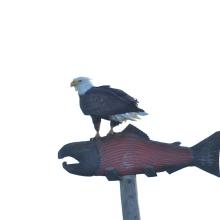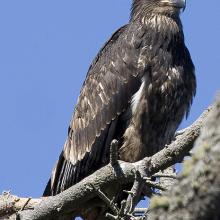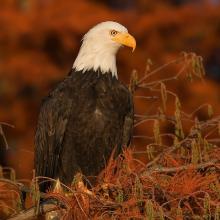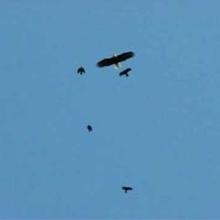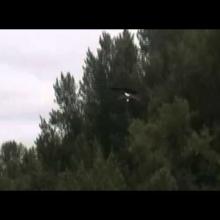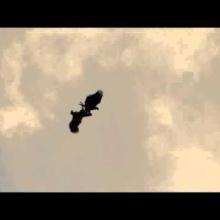

Join BirdNote tomorrow, November 30th!
Illustrator David Sibley and actor H. Jon Benjamin will face off in the bird illustration battle of the century during BirdNote's Year-end Celebration and Auction!
Immature Bald Eagles look so different from mature Bald Eagles that John James Audubon thought they were a different species entirely! Sitting about three feet tall, these majestic birds have wingspans of more than six feet. Stretch your arms as far as you can, and imagine a bird whose reach is even greater!
BirdNote®
Bald Eagle - National Symbol
Written by Frances Wood
This is BirdNote.
[Bald Eagle calling]
Look high into the top branches of a tall tree, and you may see the source of this call — a Bald Eagle.
[Bald Eagle calling]
Yes, that squeaky-door sound comes from the official bird of the United States of America. Sitting about three feet tall, this majestic bird has a wingspan of more than six feet. Stretch your arms as far as you can, and imagine a bird whose reach is even greater!
[Bald Eagle calling]
Mature Bald Eagles have snowy-white heads and tails and powerful, dark brown bodies. Their eyes, beaks and taloned feet are shades of bright orange and yellow.
Immature Bald Eagles, on the other hand, look so different that John James Audubon thought they were another species entirely. Young Bald Eagles are a patchwork of dark mottled colors, and their eyes, feet and beaks are drabber shades of gray, brown and yellow. It can take young eagles up to four years before they grow into their iconic adult colors.
Even with a call that sounds like a rusty gate, [Bald Eagle calling] the Bald Eagle is lord of the landscape.
[Pair of Bald Eagles calling]
Go eye to eye with a Bald Eagle when you come to our website, BirdNote.org.
I’m Michael Stein.
###
Producer: John Kessler
Managing Producer: Jason Saul
Editor: Ashley Ahearn
Associate Producer: Ellen Blackstone
Assistant Producer: Mark Bramhill
Narrator: Michael Stein
Bird sounds provided by The Macaulay Library at the Cornell Lab of Ornithology, Ithaca, New York. Recorded by J. Storm.
BirdNote’s theme music was composed and played by Nancy Rumbel and John Kessler.
©2019 BirdNote July 2019
BAEA-01-2009-02-16 BAEA-01c




